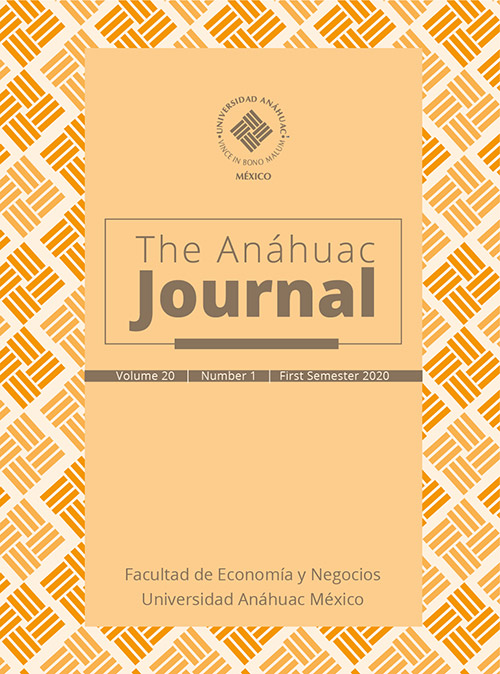El comportamiento asimétrico de los costos y gastos pegajosos (2001-2017)
Contenido principal del artículo
Resumen
Analizar el comportamiento de los costos y gastos siempre ha sido una preocupación para los usuarios de los sistemas de información financiera. En particular, a partir de 2003, existe un mayor interés por estudiar el fenómeno de la pegajosidad de los costos (sticky costs en inglés) y gastos relativos a la variación de las ventas. A fin de profundizar en el tema, nos dimos a la tarea de investigar si en México la pegajosidad durante los períodos con crisis (2008–2011) es diferente a la de los períodos sin crisis (2002–2007 y 2012–2017), y si la pegajosidad de los costos es asimétrica a la de los gastos. Esto se realizó a partir de una selección de 59 emisoras de la Bolsa Mexicana de Valores (BMV), utilizando un modelo de regresión probado, y se pudo validar la existencia de este fenómeno, tanto de los costos como de los gastos, y se encontró que es mayor en los costos durante los años sin crisis y mayor en los gastos en años con crisis, situaciones que requieren mayor atención.
Downloads
Detalles del artículo
Sección
The Anáhuac Journal se distribuye bajo Licencia Creative Commons Atribución-NoComercial-CompartirIgual 4.0 Internacional.
Cómo citar
Referencias
administrative costs sticky?». Journal of Accounting Research, 41 (1): 47-63. https://
doi.org/10.1111/1475-679x.00095
Anderson, S. y Lenen, W. (2009). Understanding Cost Management: What can we
learn from the empirical evidence on «Sticky Costs?». Working Paper, Jesse
H. Jones Graduate School of Management; Rice University: 1-49. https://doi.
org/10.2139/ssrn.975135
Banker, R. y Byzalov, D. (2014). «Asymmetric cost behavior». Journal of Management
Accounting Research, 23 (2): 43-79.
Blanchard, O., Amighini, A. y Giavazzi, F. (2012). Macroeconomia. Madrid: Pearson.
Cartier, E.N. (octubre de 2002). Apuntes para un replanteo de la teoría de los costos
fijos. Ponencia presentada en el XXV Congreso Argentino de Profesores Universitarios
de Costos, Buenos Aires.
Del Río-González, C. (2011). Costos 2, predeterminados, de operación, y costo variable.
México: Cengage Learning.
Farley, A. (2019). 3 Reasons the Mexican Peso Is so Liquid. Investopedia. https://www.
investopedia.com/articles/forex/091715/3-reasons-mexican-peso-so-liquid.asp
Fondo Monetario Internacional, FMI (2019). Report World Economic Outlook Database.
FMI. https://www.imf.org/external/pubs/ft/weo/2019/01/weodata/index.aspx
García de León, V. (2018). «5 lecciones que dejó a México la crisis de 2008».
Expansión. https://expansion.mx/economia/2018/09/18/5-lecciones-que-dejo-amexico-
la-crisis-de-2008
Garza, J.G. (2018). «Riesgos para la economía mexicana en 2019». EGADE Ideas.
https://egade.tec.mx/es/egade-ideas/opinion/riesgos-para-la-economia-mexicanaen-
2019
Hansen, D. y Mowen, M. (2007). Accounting. Management Accounting. Manson: Thomson.
Jahan, M.A. (2006). «A Competitive Study of Direct Costing and Absortion Costing
from Managerial Perpective». The Cost and Management, 34 (5): 14-24.
Kallapur, S. y Eldenburg, L. (2005). «Uncertainty, real options and cost behavior;
evidence from Washington state hospital». Journal of Accounting Research, 43 (5):
735-752.
Neuner, J.W. y Deakin, E.B. (2005). Contabilidad de costos. Principios y práctica.
México: Limusa.
Noreen, E. y Soderstrom, N. (1997). «The accuracy of proportional cost models:
evidence from hospital service departments». Review of accounting Studies, 2 (1):
89-114.
OEC (2017). «México - Origen y aplicación de exportaciones e importaciones de
México». The Observatory of Economic Complexity. https://oec.world/en/profile/
country/mex/
Oppenheimer, A. (2018). Sálvese quien pueda. El futuro del trabajo en la era de la automatización.
México: Debate Penguin Random House.
Pamplona, E., Fiirst, C., de Jesus Silva, T. y Costa da Silva Zonatto, V. (2016). «Sticky
costs in cost behavior of the largest companies in Brazil, Chile and Mexico».
Contaduría y Administración, 61 (4): 682-704.
Pérez-Ventura, J. (2013). Geopolítica. Un mundo de bloques. Ventura. https://
vaventura.com/divulgacion/geopolitica/un-mundo-de-bloques/
Porporato, M. y Werbin, E. (2012). «Evidence of sticky costs in banks of Argentina,
Brazil and Canada». International Journal of Financial Services Management, 5 (4):
303-320.
Ramírez-Padilla, D. (2018). Contabilidad administrativa, Un enfoque estratégico para
competir. México: McGraw Hill.
Rivera, J.A. (24 de marzo de 2019). «El peso es víctima de su propia volatilidad». El Economista.
https://www.eleconomista.com.mx/mercados/El-peso-es-victima-desu-
propia-volatilidad-20190324-0003.html
Ribeiro de Medeiros, O. y De Souza Costa, P. (2004). Cost stickiness in Brazilian firms.
SSRN. http://dx.doi.org/10.2139/ssrn.632365 el 3 marzo de 2020.
Rodríguez, D. (2019). «Globalización económica: características, ventajas y ejemplos
». lifeder.com. https://www.lifeder.com/globalizacion-economica/
Rodríguez, L. (2012). Análisis de estados financieros,. Un enfoque de toma de decisiones.
México, McGraw Hill.
Ross, S. Westerfield, R. y Jordan, B. (2018). Finanzas Corporativas. México: McGraw
Hill.
Stímolo, M. y Porporato, M. (2019). «How different cost behaviour is in emerging economies?
Evidence from Argentina». Journal of Accounting in Emerging Economies.
(10), 1: 21-47. https://doi.org/10.1108/JAEE-05-2018-0050
Stímolo, M.I. y Luquez, L.S. (2015). Causas del comportamiento asimétrico de los
costos (costos pegadizos), en XXXVIII Congreso Argentino de Profesores Universitarios
de Costos. Córdoba, Argentina. https://studylib.es/doc/1062132/causasdel-
comportamiento%C2%A0asim%C3%A9trico-de-los-costos--costo
Weidenmier, M.L. y Subramaniam, C. (10 de febrero de 2003). Additional Evidence
on the Sticky Behavior of Costs. TCU Working Paper. http://dx.doi.org/10.2139/
ssrn.369941
White, G., Sondhi, A.C. y Fried, D. (2003). The Analysis and Use of Financial Statements.
New Jersey: Wiley and Sons.
World Economic Forum (2015). «Principales puntos a saber acerca de la economía
mexicana». WEF. https://es.weforum.org/agenda/2015/05/10-principalespuntos-
a-saber-acerca-de-la-economia-mexicana/
Obras consultadas
Anderson, D., Sweeney, D. y Williams, T. (2012). Estadística para negocios y economía.
México: Cengage.

